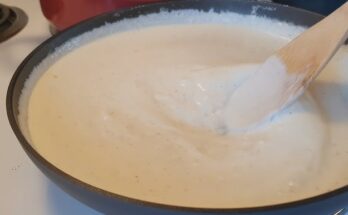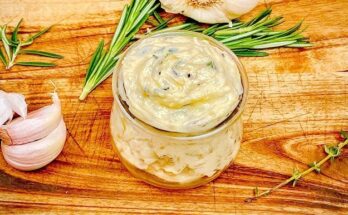Yellowfin Tuna Seared Recipe: If you’ve ever ordered seared tuna at a restaurant and thought, “Wow, I wish I could make this at home,” you’re in the right place. This step-by-step guide is going to walk you through how to make perfectly seared Yellowfin Tuna that’s crispy on the outside, buttery on the inside, and absolutely bursting with flavor. The best part? You don’t need a culinary degree or a fancy kitchen to pull it off. Just a high-quality tuna steak, a few simple ingredients, and the right technique will have you plating up a restaurant-worthy dish in minutes. Whether you’re a seafood lover or just looking to switch up your protein game, this recipe is a total winner.
Why Yellowfin Tuna is a Great Choice
Yellowfin tuna, also known as Ahi tuna, is a favorite among seafood enthusiasts for a reason. It’s lean, protein-rich, and has a firm texture that holds up beautifully to searing. Unlike other fish, it doesn’t fall apart under high heat. It’s got a mild, slightly sweet flavor that pairs well with almost any seasoning or marinade. The deep red flesh of Yellowfin also makes it visually stunning when seared—think that gorgeous rare pink center surrounded by a crispy, flavorful crust. It’s the perfect fish if you’re aiming for that high-end, gourmet feel without the fuss. Not to mention, it’s lower in fat than salmon and rich in omega-3s, which makes it a heart-healthy option you’ll feel good about eating.
What is Seared Tuna?
Seared tuna is essentially tuna that’s been quickly cooked at a high temperature—usually in a skillet or on a grill—so that the outside forms a crisp, caramelized crust while the inside remains rare or medium-rare. This method of cooking locks in the moisture and enhances the natural flavors of the fish without overcooking it. It’s a technique often used in Japanese, Hawaiian, and fusion cuisines. If you’ve had ahi tuna at sushi restaurants, chances are you’ve had it seared. The contrast between the tender, raw center and the crispy edges is what makes it so unique. It’s like the best of both worlds—steak meets sashimi.
How to Choose Fresh Yellowfin Tuna
A great seared tuna dish starts with choosing the freshest fish possible. Here’s how to pick the best Yellowfin Tuna for searing:
Appearance
Look for steaks that are bright red or deep pink. Dull, brownish tuna is a sign it’s not fresh. The flesh should be even in color with minimal browning around the edges.
Smell
Fresh tuna should smell like the ocean—clean and salty. If it smells overly fishy or sour, skip it.
Texture
The flesh should be firm to the touch, not soft or mushy. If you press it with your finger, it should bounce back quickly.
Pro Tip: Buy from a reputable fishmonger or seafood section at a trusted grocery store. If it’s labeled as “sushi-grade” or “sashimi-grade,” even better. That means it’s safe to eat rare or raw, which is essential for seared tuna.
List of Ingredients You’ll Need
Here’s what you’ll need to make perfectly seared Yellowfin Tuna:
Main Ingredients:
- 2 Yellowfin Tuna steaks (6–8 oz each, 1-inch thick)
- 2 tbsp olive oil (for searing)
- Kosher salt (to taste)
- Freshly ground black pepper (to taste)
Optional Marinade Ingredients:
- 2 tbsp soy sauce
- 1 tbsp sesame oil
- 1 tbsp rice vinegar
- 1 tsp grated ginger
- 1 tsp minced garlic
- 1 tsp honey or brown sugar
- 1 tbsp lemon or lime juice
For Garnishing/Serving:
- Toasted sesame seeds
- Sliced green onions
- Wasabi or pickled ginger (optional)
- Drizzle of sriracha mayo or ponzu sauce
With this short but powerful ingredient list, you’ll be able to unlock the full potential of your tuna steaks.
Essential Kitchen Tools for Seared Tuna
To make your seared tuna a success, having the right tools on hand can make a big difference:
- Heavy-duty skillet (cast iron preferred) or grill pan
- Tongs or fish spatula
- Sharp chef’s knife
- Mixing bowl (if marinating)
- Paper towels (for patting the fish dry)
- Meat thermometer (optional but helpful)
These tools help ensure you get an even sear, easy flipping, and perfectly sliced tuna every single time.
Step-by-Step Guide to Making Seared Yellowfin Tuna
Let’s break it down into manageable steps so you can get that perfect sear and mouth-watering flavor.
Step 1: Prep Your Tuna Steaks
Start by removing the tuna from the fridge and letting it sit at room temperature for about 15–20 minutes. This helps it cook evenly. Pat the steaks dry thoroughly using paper towels—moisture is the enemy of a good sear.
Trim off any dark bloodlines from the fish if they’re present. These parts can be overly fishy and metallic tasting.
Step 2: Marinate or Season the Tuna
If you’re going the simple route, just brush your tuna steaks with olive oil and sprinkle generously with salt and freshly cracked black pepper.
Want extra flavor? Whisk together the marinade ingredients and let the steaks sit in it for 15–30 minutes in the fridge. Don’t go longer, or the acid will start to “cook” the fish.
Step 3: Preheat Your Pan or Grill
Heat a heavy skillet (cast iron is ideal) over medium-high to high heat until it’s smoking hot. This is key—don’t add the fish until the pan is scorching. Add a tablespoon or two of oil and swirl to coat.
Step 4: Searing the Tuna to Perfection
Gently place the tuna steaks in the hot pan. Don’t crowd the pan—do one at a time if necessary. Let it sear without moving for 1 to 1.5 minutes. You want a deep golden-brown crust to form.
Flip the tuna and sear the other side for another 1 to 1.5 minutes.
The goal is rare to medium-rare doneness—warm on the outside, cool and pink in the center. If you want it more done, cook an extra 30–60 seconds per side, but be careful not to overcook.
Step 5: Resting and Slicing
Remove the tuna from the pan and let it rest for 5 minutes. This allows juices to redistribute.
Using a sharp knife, slice the tuna against the grain into thin strips—about 1/4 inch thick. Sprinkle with sesame seeds or green onions and serve immediately.
Best Marinades & Seasoning Options
Want to level up the flavor of your seared yellowfin tuna? Marinades and seasonings are your best friends. You can go bold, spicy, tangy, or even sweet depending on your mood or the theme of your meal.
Asian-Inspired Marinade
This one’s a classic:
- 2 tbsp soy sauce
- 1 tbsp sesame oil
- 1 tsp rice vinegar
- 1 tsp grated ginger
- 1 garlic clove (minced)
- A splash of lime juice
- Optional: A dash of sriracha or chili flakes for heat
Let the tuna soak in this marinade for about 20–30 minutes before searing. It creates a beautiful, umami-rich crust and complements the naturally mild flavor of the fish.
Mediterranean Rub
Skip the liquid marinade and try a dry rub instead:
- Sea salt
- Cracked black pepper
- Dried oregano
- Lemon zest
- Smoked paprika
- Crushed coriander seeds
Rub it all over the tuna steak before searing. This version pairs beautifully with couscous or grilled veggies.
Cajun Crust
Go bold with:
- Cajun seasoning
- Garlic powder
- Onion powder
- Cayenne pepper (optional, for extra kick)
This spicy rub brings the heat and gives the seared crust a satisfying crunch.
Mix and match seasonings with sauces and sides to keep your seared tuna dishes exciting every time.
Internal Temperature Guide for Seared Tuna
Getting the internal temperature right is crucial for that perfect seared tuna. Remember, seared tuna is not fully cooked through—it’s meant to be rare or medium-rare in the center.
Here’s a quick guide:
| Doneness | Internal Temp | Appearance |
|---|---|---|
| Rare | 90–100°F (32–38°C) | Cool, deep red center |
| Medium-Rare | 100–110°F (38–43°C) | Warm, pink center |
| Medium | 110–125°F (43–52°C) | Slightly pink, firmer |
| Well Done | 130°F+ (54°C+) | Fully cooked, no pink |
For the best experience, aim for rare to medium-rare. Use a meat thermometer if you’re unsure—insert it into the center right after searing to check.
Overcooked tuna becomes dry and loses that melt-in-your-mouth texture. Trust your instincts and don’t walk away from the pan!
Serving Suggestions for Seared Yellowfin Tuna
Seared tuna can be the star of the show or a flavorful sidekick—it all depends on how you serve it. Here are a few ideas that’ll make your dish shine:
- Tuna Tataki Style: Slice it thin, drizzle with ponzu sauce, and sprinkle with sesame seeds and scallions.
- Poke Bowl Style: Add tuna slices to a bowl of sushi rice with avocado, cucumber, edamame, and pickled ginger.
- Salad Topping: Top a bed of mixed greens, arugula, or spinach with tuna slices, cherry tomatoes, boiled eggs, and a zesty vinaigrette.
- Tuna Tacos: Slice the tuna and serve in corn tortillas with slaw, avocado, and spicy mayo.
- Over Noodles or Rice: Serve with soba noodles or jasmine rice and a drizzle of teriyaki or soy glaze.
Don’t forget the garnishes—microgreens, pickled onions, or a sprinkle of sea salt can elevate the final look and taste.
Side Dishes that Pair Perfectly
When you’ve got such a bold main dish, the sides need to complement, not compete. Here are some tasty and balanced pairings:
Light and Fresh
- Steamed edamame with sea salt
- Cucumber salad with rice vinegar and sesame
- Miso soup or clear broth with scallions
Starchy Favorites
- Garlic mashed potatoes
- Coconut jasmine rice
- Crispy roasted sweet potatoes
Greens and Veggies
- Grilled asparagus or zucchini
- Sautéed spinach with garlic
- Roasted brussels sprouts with balsamic glaze
Whether you’re going Asian, Mediterranean, or fusion, pick sides that balance out the richness of the tuna.
Sauce Options for Added Flavor
A perfectly seared tuna steak is delicious on its own—but a great sauce can make it unforgettable. Here are some easy and flavorful sauces to serve alongside:
Ponzu Sauce
A light, citrusy Japanese sauce:
- 2 tbsp soy sauce
- 1 tbsp rice vinegar
- 1 tbsp lemon or yuzu juice
- 1 tsp mirin (optional)
- Mix and drizzle over sliced tuna.
Spicy Mayo
Creamy with a kick:
- 2 tbsp mayo
- 1 tsp sriracha
- Dash of lemon juice
- Stir together and serve on the side or in a squeeze bottle for fancy plating.
Wasabi Cream
For a sharp contrast:
- 1 tbsp sour cream
- 1 tsp wasabi paste
- 1 tsp lemon juice
- A pinch of salt
Garlic Soy Glaze
Rich and savory:
- 2 tbsp soy sauce
- 1 tsp honey
- 1 minced garlic clove
- Simmer in a small saucepan until thickened.
Experiment with these sauces to find your favorite combo!
Storing and Reheating Leftovers
Seared tuna is best eaten fresh, but if you’ve got leftovers, here’s how to keep them tasty:
Storage Tips
- Wrap tightly in plastic wrap or foil.
- Store in an airtight container.
- Refrigerate for up to 2 days.
- Do not freeze seared tuna—it ruins the texture.
Reheating Tips
Avoid the microwave! It will overcook and dry out your tuna.
Instead:
- Let it come to room temp for 15–20 minutes.
- Sear quickly in a hot skillet for 30 seconds per side just to warm the outside.
- Or enjoy cold—sliced tuna over salad or in a wrap is just as delicious.
Common Mistakes to Avoid When Searing Tuna
Even experienced cooks slip up sometimes. Avoid these common errors for tuna that turns out perfect every time:
- Overcooking – The #1 mistake. Yellowfin tuna should be rare to medium-rare. Anything more, and you lose that buttery center.
- Starting with Cold Tuna – Cold fish won’t cook evenly. Let it sit at room temp before searing.
- Too Much Marinade Time – Acidic marinades (with lemon or vinegar) can “cook” the fish. Keep it under 30 minutes.
- Not Patting the Tuna Dry – Moisture prevents browning. Always dry your tuna well before searing.
- Pan Not Hot Enough – If your skillet isn’t screaming hot, you won’t get that golden crust.
- Using the Wrong Oil – Olive oil is fine, but for higher heat, use avocado or grapeseed oil.
- Slicing the Wrong Way – Cut against the grain to keep the texture tender, not chewy.
Nutritional Benefits of Yellowfin Tuna
Yellowfin tuna isn’t just delicious—it’s a nutritional powerhouse, too.
- High in Protein – Around 25 grams per 3-ounce serving.
- Low in Fat – Unlike salmon, tuna is lean and low in saturated fat.
- Rich in Omega-3s – Supports heart health and brain function.
- Packed with Vitamins – B12, B6, niacin, and selenium.
- Low in Calories – Great for weight management.
It’s ideal for keto, paleo, or low-carb diets, and it keeps you full and satisfied without the bloat.
FAQs about Yellowfin Tuna Seared Recipe
1. Can I use frozen tuna for searing?
Yes, but make sure it’s sushi-grade and completely thawed in the fridge before searing. Pat it very dry before cooking.
2. How do I know when my tuna is seared perfectly?
Look for a browned crust on the outside and a deep red or pink center. If it feels warm on the outside but still cool in the middle, you’re golden.
3. What’s the difference between yellowfin and ahi tuna?
Nothing really—”Ahi” is the Hawaiian name for both yellowfin and bigeye tuna. Both are commonly used in seared dishes.
4. Is seared tuna safe to eat rare?
Yes, as long as it’s fresh and labeled sushi- or sashimi-grade, it’s safe to eat rare or even raw.
5. What wine pairs best with seared tuna?
Try a crisp white wine like Sauvignon Blanc, a light Pinot Noir, or even a dry rosé for balance and brightness.
Conclusion
Searing yellowfin tuna at home might seem like a gourmet task, but as you’ve seen in this step-by-step guide—it’s surprisingly simple and incredibly rewarding. With the right ingredients, a sizzling pan, and a little bit of attention, you can create a restaurant-quality meal in under 15 minutes. Whether you keep it classic with salt and pepper or experiment with global flavors and marinades, seared tuna is a versatile dish that always impresses.
The best part? It’s clean, lean, and bursting with flavor—making it a perfect choice for weeknight dinners, date nights, or meal-prep lunches. So next time you see that beautiful slab of yellowfin at the store, don’t hesitate. Grab it, sear it, and savor every bite.



